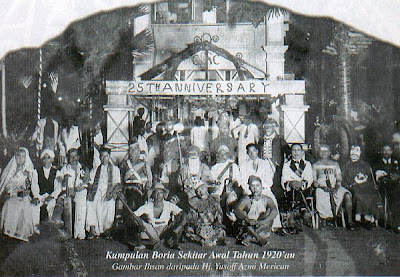



Boria is another traditional performing art form which owes itsorigin to Persia, one of its meanings is ‘carpet’ where “grief-stricken mourners would sit wailing and crying, at times in a state of frenzy, during the first ten nights of...Muharram”
The less-known interpretation of boria is from the Hindi word borai which means crazy or frenzy This interpretation has probably arisenafter the frenzy of performances in Penang when boria was at its height. As competitions were held between the Boria groups, the frenzy occurred when competition was strife among the costumed performers who paraded the groups’ flags of different colours and designs. This inevitably ended in fights, Apparently, at its peak, apart from the main evening performances there were also performances in the day called kuli kalin where the groups paraded and sang in the streets with masks of different designs in the first five days of Muharram. This was done to collect funds for the performances.
Boria is believed to have been brought in between 1845 and 1874 by the “Indians of Shiah origin” The reference to the origin of this performance is also made to the incident at Karbala and for the first ten days of Muharram, Boria was performed to reminiscence this incident. Still making reference to its Indian origins Ghulam states that “...boria performances in Shiah communities in India is the inclusion of passion plays based upon the theme of martyrdom of Ali’s family” (ibid). This genre of performance is believed to have been used to promote understanding of Shi’ite
The plays are the main part of Boria whilst the singing supports the performance. Both the frenzy and mayhem it caused and the religious-political significance of these performances led to the disintegration of Boria. As a start to this disintegration, Boria was changed to Ria denoting merriment with no strong religious significance.
From performances of plays it evolved into choric performances where the tukang karang (lead singer) sings the ‘story’, followed by repetitive singing of the ‘sailors’ (chorus) in between each verse. At the height of Boria the tukang karang (lead singer) must be able to improvise his lyrics And have melodious voice to attract not only audiences to earn fame but patrons. A good tukang karang must also use the right lyrics to praise his patron in the hope of getting better financial support.

Tiada ulasan:
Catat Ulasan